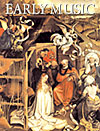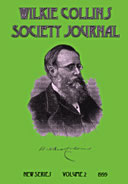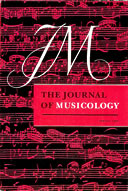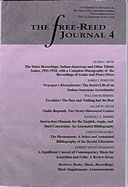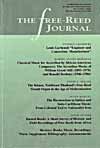Research on Concertinas
Directory
Resources in the Concertina Library for concertina research.
-
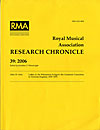 Ladies in the Wheatstone Ledgers: the Gendered Concertina in Victorian England, 1835–1870
Ladies in the Wheatstone Ledgers: the Gendered Concertina in Victorian England, 1835–1870
- by Allan W. Atlas
- This study looks at the 978 women for whom there are 1,769 transactions—about 12% of the
total—recorded in nine extant Wheatstone & Co. sales ledgers that list the firm’s day-to-day sales
from April 1835 to May 1870. It is in two parts: (1) an Introduction, which analyses the data presented
in the Inventory from a demographic-sociological point of view and places Wheatstone’s commerce
with women into the context of its business activity as a whole; and (2) the Inventory (with
three appendices), which lists every transaction for each of the 978 women, identifies as many of them
as possible, and offers a miscellany of comments about both the women and the transactions.
Royal Musical Association Research Chronicle v. 39 (2006). 239 pages.
Briefly,
the roster of Wheatstone’s female customers reads like a list of Victorian England’s rich-and-famous:
the Duchess of Wellington and 146 other members of the titled aristocracy (more than twice as many
as their male counterparts), the fabulously wealthy philanthropist Angela Burdett Coutts, members
of the landed gentry, and such mainstays of London’s musical life as the guitarist Madame R. Sidney
Pratten, the organist Elizabeth Mounsey, and the contralto Helen Charlotte Dolby, as well as a large
number of Professors of Concertina.
- Posted 21 March 2007
- » read full article
-
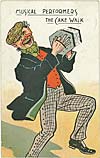 The Life and Times of the Concertina:
the adoption and usage of a novel musical instrument
with particular reference to Scotland
The Life and Times of the Concertina:
the adoption and usage of a novel musical instrument
with particular reference to Scotland
- by Stuart Eydmann
-
This much-anticipated study is the first book-length account of the history and
development of the concertina, in the context of the people who played it and their
music. It is based on field work as well as historical research,
and deals with the concertina in traditional music, art music, sacred music,
band music, the music hall, and many forms of popular
music—reflecting the richness, contradictions, and complexities of
music and society over the more than 150 years since the invention
of the concertina as the high-tech sensation of its day.
Twelve chapters, bibliography of more than 400 items, over 90 figures and musical examples, 365 pages.
Text of thesis for the Ph.D. degree, Open University, 1995.
Supervisors: Dr Peter Cooke and Dr Richard Middleton.
- Posted 15 August 2005
- » read full document
-
 The concertina as an emblem
of the folk music revival
in the British Isles
The concertina as an emblem
of the folk music revival
in the British Isles
- by Stuart Eydmann
-
The post-war folk and traditional music revival in the British Isles was a complex
phenomenon which involved more than just the simple rediscovery and promotion of
neglected music and song. The ideology of key individuals was important in
determining the scope and subsequent diction of the revival including the sources of
the revived repertory and how it should be re-packaged. The selection and use of
appropriate musical instruments was a major issue and, for a time at least, the
concertina family was endorsed by the revivalists to the extent that it could act as a
symbol of the revival itself. This paper identifies and discusses the processes involved.
First published in
British Journal of Ethnomusicology,
vol. 4 (1995), pp. 41–49.
- Posted 15 August 2005
- » read full document
-
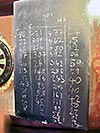 Serial Number Muddle in Early Wheatstone Ledgers
Serial Number Muddle in Early Wheatstone Ledgers
- by Wes Williams
-
A major contribution to the muddling of serial numbers in the early ledgers is that
multiple ranges of serial numbers are in use at any one date, and this is further
complicated by instrument exchanges and hires. The multiple ranges begin as a feature of sales
before 1850, but after that the multiple range-lines dominate the structure of sales,
with many simultaneous ranges extended over longer periods. Scatter-plots of
serial numbers and dates transcribed from the Wheatstone Ledgers reveal the pattern.
This is a preliminary version dealing only with the
first four ledgers (to early 1854); the completed article will appear soon.
- Posted 15 December 2005
- » read full article
-
 Wheatstone Concertina Pricelists
Wheatstone Concertina Pricelists
- collected by Chris Algar
-
A large collection of pricelists issued by C. Wheatstone & Co., mostly found
in old concertina cases without further identification. From internal evidence it is
possible to date the lists c. 1915 to c. 1965 (plus one very early pricelist dated 1848,
from the collection of the Horniman Museum, and a list published as an advertisement
in a trade directory in 1859). These lists contain information about Wheatstone
model numbers and descriptions which are useful to interpret the Wheatstone Concertina Ledgers.
- Posted 15 May 2003
- » go to directory
-
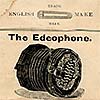 Lachenal Concertina Pricelists
Lachenal Concertina Pricelists
- collected by Chris Algar
-
Most of the earlier "pricelists" here were printed as trade advertisements, in dated serials.
Those actually issued as separate pricelists were found in old concertina cases; from internal evidence it is
possible to date these c. 1890 to c. 1925.
- Posted 07 March 2005
- » go to directory
-
 Signor Alsepti and “Regondi’s Golden Exercise”
Signor Alsepti and “Regondi’s Golden Exercise”
-
by Allan Atlas
-
Discussion and explanation with new fingering of a celebrated excercise from James Alsepti's English tutor,
published by Lachenal c. 1895, with the explanation “The following exercise, which has never before been
published, was taught to Signor Alsepti by Regondi. It is
very difficult for all instruments, especially the Concertina, and to thoroughly master it with the correct
fingering &c. will enable the Pupil to play passages in all keys.”.
As published in
Concertina World 426 supplement (2003) pp. 1-8.
-
Posted 22 December 2003
-
» read full article
-
 Center for the Study of Free-Reed Instruments
Center for the Study of Free-Reed Instruments
-
by Allan Atlas
-
The CSFRI, part of the Doctoral Program in Music
at the Graduate Center, City University of New York, is
a resource for the scholarly study of all free-reed instruments
(sheng, harmonica, accordion, etc.)
and contains much of interest to concertinists. The site has news
of upcoming concerts, and a listing of books, articles,
recordings, and research material available at the Center's archives.
CSFRI published The Free-Reed Journal (four volumes, 1999–2003),
and now co-publishes the
Papers of the International Concertina Association (PICA)
with the ICA (2004– ).
-
-
Posted 15 February 2003
-
» go to website
-
 The Fayre Four Sisters: Concertina Virtuosi
The Fayre Four Sisters: Concertina Virtuosi
-
by Richard Carlin
- Interviews with Inga, Tina, Sylvia, and Lillian Webb, the “Fayre
Four Sisters,” concertinists on the British music hall and vaudeville circuits.
The sisters were daughters of Joseph Webb (JoJo of the Brothers Webb), and part of
the circle including George Jones, who gave them their first concertina lessons, and
of Frank Butler.
As published in The Free-Reed Journal No. 3 (2001), pp 79–88.
-
Posted 15 January 2005
-
» read full article
-
» read full article in pdf
-
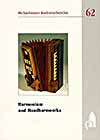 An Annotated Catalogue of Historic European Free-Reed Instruments from my Private Collection
An Annotated Catalogue of Historic European Free-Reed Instruments from my Private Collection
-
by Stephen Chambers
-
A very important paper describing nineteen instruments which illustrate key points in the development of
European free-reed instruments, with large color photographs.
This paper was presented at the 20th Musikinstrumentenbau-Symposium at Stiftung Kloster Michaelstein, held
19–21 November 1999, to coincide with an exhibition of the instruments.
As Published in Harmonium und Handharmonika (Michaelsteiner Konferenzberichte 62), edited by Monika Lustig,
Michaelstein, 2002, pp. 181-194.
-
Posted 15 January 2004
-
» read full article
-
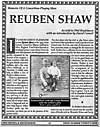 Memoirs of a Concertina-Playing Man: Reuben Shaw
Memoirs of a Concertina-Playing Man: Reuben Shaw
-
as told to Phil Hopkinson, with an introduction by David Cornell
-
Memoirs of a player, a teacher, a link with the great British concertina tradition, and
a fine story teller, who has played the Maccann Duet concertina for over fifty years.
Reprinted from Concertina & Squeezebox,
issue 29 (1993), pp. 12-17. Posted to honor Reuben Shaw’s 90th birthday, and to commemorate his
appearance at the English Country Music Weekend at High Bradfield, Nr Sheffield, UK, 20-22 June 2003.
-
Posted 15 June 2003
-
» read full article in pdf
-
 The Concertina Man
The Concertina Man
-
Presented by Peter Day,
Produced by Neil Koenig
-
BBC programme on the history and music of the concertina,
focusing on its inventor Sir Charles Wheatstone as a somewhat belated
recognition of his bicentenary in 2002. In addition to the presenter, Peter Day,
the program features (in order of appearance)
Bob Gaskins, Brian Bowers, Margaret Birley, Stephen Chambers,
Frank James, Douglas Rogers, Sean Minnie, and Steve Dickinson. The program
was produced by Neil Koenig.
BBC World Service programme broadcast 07 September 2004.
-
Posted 22 November 2004
-
» read full article
-
 The Lachenal Sisters Visit Edinburgh, 1865–1866
The Lachenal Sisters Visit Edinburgh, 1865–1866
-
by Robert Gaskins
-
At Christmas of 1865–1866, three young daughters of the late Louis Lachenal gave a
series of concerts in Edinburgh introducing “concerted music” played
on treble, tenor, and bass concertinas. We think this was also exactly the period when
Lachenal & Co. had lost their contract to manufacture concertinas for Wheatstone,
making it important to publicize Lachenal’s own brand.
Based on clippings from The Scotsman newspaper, Edinburgh, notices of
concerts and reviews, October 1865 through January 1866.
-
Posted 01 February 2005
-
» read full article
-
 The Wicki System—an 1896 Precursor of the Hayden System
The Wicki System—an 1896 Precursor of the Hayden System
-
by Robert Gaskins
-
The concertina keyboard system known today as the "Hayden" system,
which was independently discovered by Brian Hayden and patented by him in 1986,
had also been discovered and patented 90 years earlier by a Swiss inventor
named Kaspar Wicki. Wicki's 1896 Swiss patent (CH13329) is clear and unambiguous, including
a keyboard diagram labeled in standard musical notation.
-
Posted 01 March 2004
-
» read full article
-
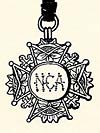 Professor Maccann: “America’s Champion Concertinist”
Professor Maccann: “America’s Champion Concertinist”
-
by Robert Gaskins
-
“PROFESSOR MACCANN, the celebrated concertinist, has
brought back with him from America a fine medal, which
became his property by a rival musician, Amducas Vestman,
failing to meet the Professor in a concertina contest
for the championship and $300. ...”
From The Era newspaper, London, 2 May 1891.
-
Posted 01 June 2003
-
» read full article
-
 Prof. Maccann’s North American Tour (1890–1891)
Prof. Maccann’s North American Tour (1890–1891)
-
by Robert Gaskins
-
Newspaper theatrical notices from the Brooklyn (New York) Daily Eagle describe John Hill Maccann’s
appearances at Hyde and Behman’s Variety Theater, Brooklyn, in November 1890 and February 1891.
Updated 22 December 2003: added a notice from the New York Times for 27 January 1891, during
the same North American tour.
-
Posted 01 June 2003
-
» read full article
-
 Professor Maccann Performs in Plymouth
Professor Maccann Performs in Plymouth
-
by Robert Gaskins
-
Extended review of a concert presented by Professor Maccann at
the Plymouth Mechanics’ Institute “on an instrument which
he has just patented,” from the Western Figaro newspaper,
Plymouth, 27 February 1885.
-
Posted 01 July 2003
-
» read full article
-
 Wheatstone Anglos with Serial Numbers 50,000+
Wheatstone Anglos with Serial Numbers 50,000+
-
by Robert Gaskins
-
Between 1938 and 1974 Wheatstone & Co.
manufactured concertinas in two parallel series of serial numbers;
Englishes and Duets were given numbers #3XXXX, and Anglos were given
numbers #5XXXX. During these 37 years Wheatstone manufactured about
2,129 Englishes and Duets, with serial numbers from about #34955
through #37083, and some 9,498 Anglos, with serial numbers from #50001
through #59498. Yet, for unknown reasons, this vast population of
late Wheatstone Anglos with #50000+ numbers are not seen nearly as
often as one would expect.
The original version of this article appeared on the net at
concertina.net,
and at
Concertina FAQ.
-
Posted 23 June 2001
-
» read full article
-
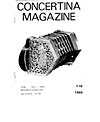 Fingering Systems for Duet Concertina
Fingering Systems for Duet Concertina
-
by Brian Hayden
-
Overview of all the fingering systems for duet concertina which
turned up in Hayden's review of prior art while preparing his own patent application.
As published in Concertina Magazine (Australia)
16 (1986): 19-23; 17 (1987): 7-9; 18 (1987): 11-15; 19 (1987): 6-10.
-
Posted 15 November 2001
-
» read full article in pdf
-
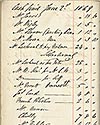 Wheatstone Concertina Ledgers
Wheatstone Concertina Ledgers
-
Directory
-
Historical business records of C. Wheatstone & Co. from
the Horniman Museum in London. Earlier ledgers from the Wayne Archives
contain company sales records from the late 1830s to the 1860s
along with production records from the 1860s to the 1890s and some
early records of wages and other payments. Later ledgers from the Dickinson Archives
contain production records from 1910 to 1974. All surviving ledgers
have been digitized (some 2,300 pages in total) and made available free on the web for
private research.
The same material is also available to buy on an inexpensive CD.
Includes an introduction to the project by Margaret Birley, Keeper of Musical Instruments at
the Horniman Museum, and an article by Robert Gaskins describing in detail how the ledgers
were digitized.
-
Posted 15 June 2003; Updated 15 June 2005
-
» go to directory
-
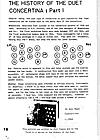 History of the Duet Concertina
History of the Duet Concertina
-
by Phil Inglis
-
When it was written, this was the only survey article on the subject, plus some anecdotes. The
last twenty years have produced some additional information.
As published in Concertina Magazine (Australia), 12 (Autumn, 1985): 18-19,
13 (Winter, 1985): 18-20, 14 (Spring 1985): 11-13.
-
Posted 15 February 2003
-
» read full article in pdf
-
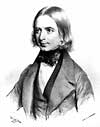 Giulio Regondi in Ireland
Giulio Regondi in Ireland
-
by Thomas Lawrence
-
New information about Giulio Regondi, guitarist and concertinist, who performed on
Wheatstone’s patent concertina in Ireland as early as 1834, the earliest reference to the concertina
in the British Isles.
In PaGes [University
College, Dublin, postgraduate students in the Faculty of Arts] 6 (1999),
on the web at
http://www.ucd.ie/pages/99/articles/lawrence.pdf.
-
Posted 15 August 2003
-
» go to website
-
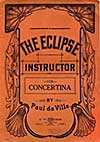 Back to the Future: De Ville’s The Concertina and How to Play It
and Other Tutors
Back to the Future: De Ville’s The Concertina and How to Play It
and Other Tutors
- by Randall C. Merris
-
Paul de Ville's tutor (1905) is one of the most widely available sources
of basic instruction and tunes for the Anglo concertina. It
has links to both earlier and later periods; most of its tunes and
other material were taken from earlier publications, and most of its
contents reappeared seventy years later in a tutor which is still available
for purchase.
- Posted 15 February 2003
- » read full article
-
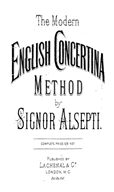 Instruction Manuals for the English, Anglo, and Duet Concertina: An Annotated Bibliography
Instruction Manuals for the English, Anglo, and Duet Concertina: An Annotated Bibliography
- by Randall C. Merris
-
A comprehensive bibliography with more than 200 citations for
concertina tutors that were published from the 1840s to the present.
Separate sections deal with English, Anglo, and Duet tutors.
The annotations contain
considerable historical material on concertina makers, authors and teachers, performers,
and publishers in the UK, US, and elsewhere. The web version incorporates citations for tutors
that have appeared or were located subsequent to the original publication (about 35 more by 2005)
and adds over 100 scanned photographs of tutor covers.
A number of the tutors are available scanned
in full on this website, and these are indicated in the entries.
The original publication was in The Free-Reed Journal 4 (2002): 85-118,
and a PDF version of the printed article is also available online.
- Posted 01 April 2003; last updated 31 August 2005
- » read full article
- » read Part 1, "English Concertina"
- » read part 2, "Anglo Concertina"
- » read part 3, "Duet Concertina"
- » read original article (without updates) in pdf"
-
 Concertina Connection
Concertina Connection
-
by Wim Wakker
-
With the goal of reintroducing the English concertina into classical music,
this site features articles on playing skills (beginner to advanced)
with music scores, sound files, and photographs. The site offers
new Geuns-Wakker concertinas and restored vintage instruments,
extensive restoration services and replacement parts,
and re-published Victorian and contemporary sheet music.
There are a number of MP3 sound files of older Wheatstone and Lachenal concertinas.
-
-
Posted 15 November 2001
-
» go to website
-
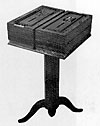 The Wheatstone English Concertina
The Wheatstone English Concertina
- by Neil Wayne
-
Survey article covering the Wheatstone English Concertina, the only
published source for much of Neil Wayne's path-breaking research.
As published in The Galpin Society Journal 44 (1991), 117-149. (The
online version does not yet perfectly match the printed version.)
- Posted 01 January 2005
-
» go to website
-
 A Wheatstone Twelve-Sided 'Edeophone' Concertina with Pre-Maccann Chromatic Duet Fingering
A Wheatstone Twelve-Sided 'Edeophone' Concertina with Pre-Maccann Chromatic Duet Fingering
-
by Neil Wayne, Margaret Birley, and Robert Gaskins
-
A duet concertina (serial no. 35074) with a unique fingering arrangement, made by Wheatstone
in 1938, turns out to be a realization of a design from Wm. Wheatstone's patent of 1861.
The instrument is twelve-sided, a Registered Design feature of Lachenal & Co., and it
turns out to be one of at least sixteen twelve-sided instruments made by Wheatstone between
1934 and 1941. The instrument is now in the collection of the Horniman Museum, London.
As published in The Free-Reed Journal 3 (2001): 3-17.
This HTML version of the article adds a number of additional photographs and
active links to many of the sources cited in the published article.
Updated 15 August 2003: Footnote 11 updated to record that Randall C. Merris has
located instrument serial #33301, another of the set of three twelve-sided 40-key Anglos.
-
Posted 15 November 2001; last updated 15 August 2003
-
»
read full article
-
»
read original article (without updates or additions) in pdf
-
 A Chat with Brian Hayden
A Chat with Brian Hayden
- by Wes Williams
-
Brian Hayden was interviewed in 2001 about his background, his invention of
the Hayden System, his views on other duet systems, and his suggestions
for learning and playing the duet concertina. Contains keyboard diagrams
for nine duet systems: the Early Wheatstone Duett, Early Wheatstone Double, Maccann,
Jeffries, Crane (Triumph), Linton, Rust ("Piano"), Late Wheatstone Chidley, and Hayden.
(There is also
a PDF version of the article.)
Also published at concertina.net.
- Posted 15 February 2003
- » read full article
- » read full article in pdf
-
 The Concertina History Resource
The Concertina History Resource
-
by Wes Williams
-
This site (still early in its development) contains historical
information about concertinas and concertina makers. A timeline
helps to organize information about the changes of name and address
among the major makers as bits of data are discovered. One
use for this information is to help in answering the question “when
was my concertina made?” which is very difficult to answer
for most makers.
-
-
Posted 15 February 2003
-
» go to website
Do you know another resource that we should include?
Tell us about it.
Reprinted from the Concertina Library
http://www.concertina.com
© Copyright 2000– by Robert Gaskins
|
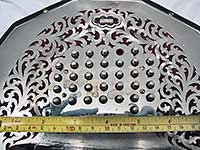
Wheatstone 12-sided duet
No. 35074 in the
Horniman's conservation lab
Contents
- Directory: Concertina Research
- Ladies in the Wheatstone Ledgers
by Allan Atlas
- The Life and Times of the Concertina
by Stuart Eydmann
- The concertina as an emblem of the folk music revival
in the British Isles
- Serial Number Muddle in Early Wheatstone Ledgers
by Wes Williams
- Wheatstone Concertina Pricelists
from Chris Algar
- Lachenal Concertina Pricelists
from Chris Algar
- A 41-cent emendation
by Allan Atlas
- Collins, Count Fosco, and the Concertina
by Allan Atlas
- George Gissing's Concertina
by Allan Atlas
- Signor Alsepti and “Regondi’s Golden Exercise”
by Allan Atlas
- Giulio Regondi: Two Newly Discovered Letters
by Allan Atlas
- Center for the Study of Free-Reed Instruments
by Allan Atlas
- The Fayre Four Sisters: Concertina Virtuosi
by Richard Carlin
- Frank Butler: An Interview
by Richard Carlin
- An Annotated Catalogue of Historic European Free-Reed Instruments from my Private Collection
by Stephen Chambers
- Louis Lachenal: "Engineer and Concertina Manufacturer" (Part 1)
by Stephen Chambers
- Some Notes on Lachenal Concertina Production and Serial Numbers
by Stephen Chambers
- Memoirs of a Concertina-Playing Man: Reuben Shaw
as told to Phil Hopkinson, with an introduction by David Cornell
- The Concertina Man
Presented by Peter Day,
Produced by Neil Koenig
- The Lachenal Sisters Visit Edinburgh, 1865–1866
by Robert Gaskins
- The Wicki System—an 1896 Precursor of the Hayden System
by Robert Gaskins
- Professor Maccann: “America’s Champion Concertinist”
by Robert Gaskins
- Prof. Maccann’s North American Tour (1890–1891)
Robert Gaskins
- Professor Maccann Performs in Plymouth
by Robert Gaskins
- Wheatstone Anglos with Serial Numbers 50,000+
by Robert Gaskins
- Fingering Systems for Duet Concertina
by Brian Hayden
- Wheatstone Concertina Ledgers
from the Horniman Museum
- History of the Duet Concertina
by Phil Inglis
- Giulio Regondi in Ireland
by Thomas Lawrence
- Back to the Future: De Ville’s The Concertina and How to Play It
by Randall C. Merris
- Instruction Manuals for the English, Anglo, and Duet Concertina:
An Annotated Bibliography
by Randall C. Merris
- The Concertina Connection
by Wim Wakker
- The Wheatstone English Concertina
by Neil Wayne
- A Wheatstone Twelve-Sided 'Edeophone' Concertina with Pre-Maccann Chromatic Duet Fingering
by Neil Wayne, Margaret Birley, and Robert Gaskins
- A Chat with Brian Hayden
by Wes Williams
- The Concertina History Resource
by Wes Williams
|








